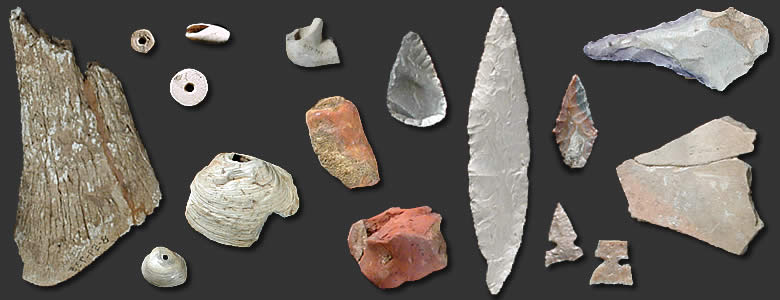|
In looking at the artifacts from Excavation 3, we
see traces of a people who farmed, hunted bison and
other game in the prairies and woods, and fished and
gathered mussel in the rivers. They also fashioned pottery
vessels of clay tempered with crushed mussel shell and
made both practical and decorative objects of bone,
shell, and chipped stone.
|
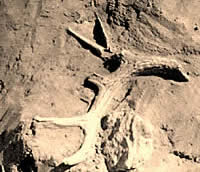
Excavators found this deer antler
and bone among camp refuse, underneath a hearth. They
are examples of the many resources suitable for food,
tools, or both used by the prehistoric dwellers at the
site.
|
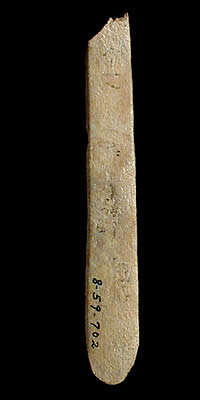
A spatulate tool with beveled edges
was made from a bison or deer rib.
|
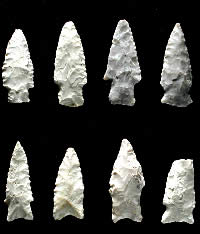
Late dart point types found at the
site. The smaller Darl points are considered "transitional"
types, among the last of the dart points still used
as the bow and arrow weaponry system came into use.
|
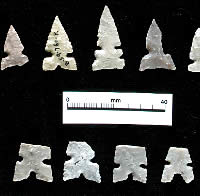
Side-notched points such as these
were found in quantity at the site. Those with side
notches only are called Washita points; those with side
and basal notches are known as Harrell points, for which
the site was named. Harrell points are found widely
in Late Prehistoric sites across Texas as well as across
the Plains and as far north as Canada.
|
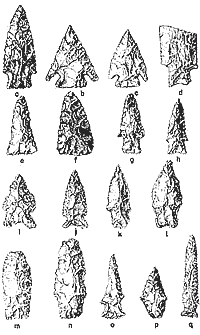
The variety of dart points found
at the Harrell site, shown in this drawing from Krieger
1946, suggests the site was used by prehistoric peoples
for several thousand years before the Plains Village
groups came to the spot.
|
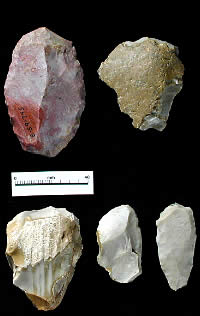
Chipped stone scrapers and cutting
tools of various shapes and sizes likely served a variety
of uses in butchering and other camp tasks. The brightly
colored pinkish-red specimen is made of Alibates "flint,"
a banded dolomite occurring chiefly in the Texas Panhandle
area to the northwest. (For more on how these stones
were procured, see the Alibates
Flint Quarries section.) |
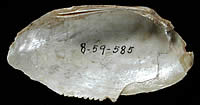
The edge of this mussel
shell has been cut, or serrated, perhaps for use as a scraping or cutting
tool. |
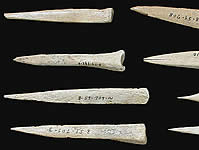
Bones of various species of animal
were sharpened to use as awls, tools to sew or punch
holes in hides for clothing, containers, or other materials.
Fiber mats were woven with the aid of pointed tools
such as these.
|
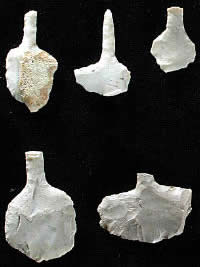
Among the large selection of perforators
or drills found at the site, about 40 were simply made
on flakes, unshaped except for the drill shaft.
|
| |
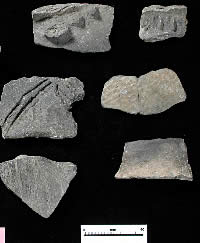
Although termed Nocona Plain, a small
number of sherds were decorated with simple exterior
designs including rounded nodes, impressions of textile
or paddle, incised lines, and parallel lines of fingernail
marks.
|
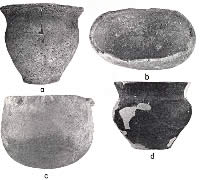
Once reconstructed, sherds of Nocona
Plain pottery from the Harrell site might resemble these
vessels found in graves in east-central Oklahoma and
northeast Texas, according to Krieger. He suggested
these vessels may have been trade ware brought into
areas where this type of pottery was not locally manufactured.
Vessels a and b were found in LeFlore County, Oklahoma.
Vessel c was from a site in Fannin County, Texas, and
Vessel d from a Titus focus burial in Titus County,
Texas. (Photo from Krieger 1946).
|

Unlike other types of pottery at
the site, these distinctive reddish sherds were not
tempered with shell and they apparently had been hand
molded rather than coiled. Based on the distinctive
red coloring on the interior, they may have once been
cups which held pigment for painting.
|
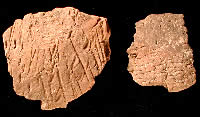
Exteriors of the reddish "paint
cup" sherds were roughened with incised lines or
other texturing, perhaps to make the vessels less slippery
to hold.
|

Cut marks and a clean-cut end indicate
this bone has been butchered by humans.
|
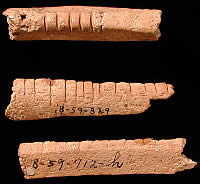
Marked with a series of carefully
incised parallel notches, these hollow bones had a purpose
we can only guess at today. Although often called "tally
bones" and considered counting devices, they are
more likely rasps used as musical or ceremonial instruments.
|

An array of beads and ornaments made
of different materials, including polished bird bones
( right), an Olivella shell bead (bottom right), mussel
shell disc beads (top, center), and disc beads of fossil
crinoid stems (bottom, center). The perforated object
at top left is made of baked clay and is probably a
spindle whorl, suggesting that cotton or other kinds
of plant fibers were woven at the site.
|
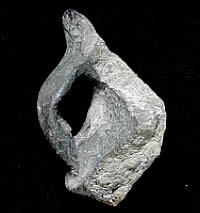
A single strap-handled sherd was
all that was found of a Brownware pottery vessel likely
made in southeastern New Mexico during the late 1400s.
|
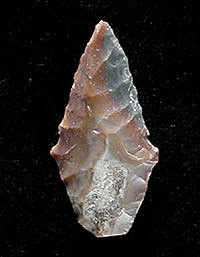
A dart point with a complex past,
this specimen was made of banded agatized dolomite,
or Alibates flint, which outcrops along the Canadian
Breaks of the Texas Panhandle some 300 miles northwest
of the site. The style of the point resembles types
more common in East Texas and Louisiana, perhaps as
early as 3000 years ago.
|
|
Over time, hundreds of stone tools, weapons,
pottery sherds, bone implements, food remains, and other items
were left behind by the various occupants of the Harrell site.
What can these bits of household debris tell us about the
people who lived along the Brazos River and what their lives
were like?
A first consideration for researchers analyzing
site remains is identifying where each item came from in the
site deposits in order to understand its placement in time.
Like many prehistoric sites, the Harrell site does not represent
a single episode of occupation by one group of people. Rather,
the types of artifacts, ranging from roughly 5000-year-old
spear points to 600-year-old arrow points, tell us that the
site had a rather long history, as is discussed in the section,
Harrell Site Reconsidered. The challenge for archeologists
studying the Harrell site is to determine which artifacts
date to the same time period and represent the same period
of site occupation. Because of the nature of the site itself
as well as the way it was excavated and documented, the task
of sorting things out into meaningful groupings is no easier
today than it was 70 years ago when archeology student Jack
Hughes began looking at the collections.
Here we will simplify the matter and concentrate
mainly on the materials that date from the Plains Villager
period at the Harrell site, roughly A.D. 1200-1500. This period
accounts for the bulk of the artifacts from the site and it
is this period for which the site is best known. Artifacts
known or suspected to date to earlier periods are identified
as such.
Farming Tools
Farming implements were made from a variety
of materials close at hand, including bone and antler from
both deer and bison and shell from freshwater mussel. Plains
Villager farmers commonly used hoes made of bison scapulae
(shoulder blades) that were trimmed and cut to make a flat
triangular blade, which was attached to a wooded handle. Fourteen
fragments of bison scapula hoes were found at the Harrell
site (representing at least four or five whole tools). Another
hoe was fashioned from a section cut from a bison skull near
the horn core. Bone hoes may not have been common because
of the ready availability of large thick mussel shells, some
33 of which were found that show signs of heavy wear and battering
along their edges. These large shells may have been used as
digging tools or hoes to cultivate corn and perhaps other
crops (corn cobs were the only domesticated plant remains
recognized at the site).
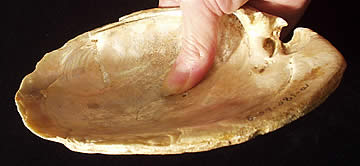
A large mussel shell with heavy edge wear
and polish likely was used as a tool. Krieger suspected that
prehistoric farmers were using them as hoes, and that the
holes found in many shells were where a stick was inserted
to form a handle. Click image to enlarge. Click here for microscopic
views of edge.
Hunting, Fishing, and Butchering
Among a variety of implements, the tool kit
of prehistoric hunters included chipped stone or bone points
to tip weapons, gear for fishing and trapping, and the knives
and other tools to process their kill.

"Turtle-backed" scrapers, so-called
for their rounded hump-back appearance, likely were hafted
in bone or wooden handles for use in butchering and preparing
animal hides. Also called snubnosed end scrapers, the scrapers
were chipped unifacially (on one side) on a stone flake and
beveled on the wide end. They are commonly found in Late Prehistoric
sites, particularly those of bison hunting people.
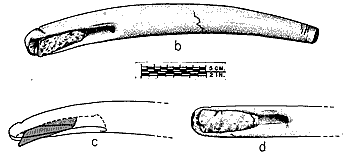
Plains Indians often hafted small, plano-convex,
chipped stone end scrapers into antler tine handles for use
in hide working. These specimens, from Rice County, Kansas,
show various views of scraper blades in sockets. Drawings
by Marcia Bakry (a) and G. R. Lewis (b-d), from Wedel, 1970.
Used with permission of Plains Anthropologist.
Most of the 81 dart or spear points found at
the Harrell site date to the Archaic period before the bow
and arrow was in use. Dart points were affixed to wooden darts
or small spears thrown with the use of an atlatl or spear
thrower. Their presence tells us that the site was used by
hunters at least as early as 5000 years ago, the approximate
age of the beveled-stem Nolan points. Later Archaic styles
found at the site include the broad-bladed Castroville, Marcos,
and Marshall types, all dating to the Late Archaic about 2000-3000
years ago, as well as smaller and later types such as Darl,
Ensor, and Fairland points, all dating to the very end of
the Archaic, about 1200-2000 years ago. Some of the smaller
dart points may have still been in use when the bow and arrow
was introduced.
Arrow points were much more numerous; over 550
of them were recovered from the Harrell site. Most of these
are triangular points that have side and/or basal notches
including the Harrell style, named after the site, and the
Washita point. Scallorn points, the kind found with the burials,
are much less common; only about 25 were found. There are
also various other stemmed points including Bonham and a few
Perdiz as well as unstemmed and unnotched triangular points
and preforms.
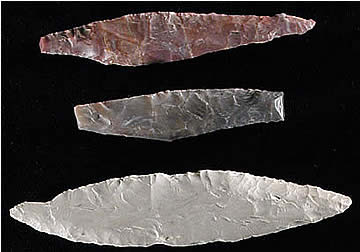
Long bifaces or knives, some beveled on
edges, were likely used in cutting meat, plant foods, or in
other tasks.
A typical tool found at Plains Village sites
and other Late Prehistoric sites with evidence for bison hunting
is the beveled knife. These stone tools were probably favored
for their durability and longevity. Beginning as long oval-shaped
thin bifaces, their edges were resharpened repeatedly through
"microflaking" or edge-beveling and reused in successive
butchering tasks. As a knife was reused and resharpened over
its "lifetime," it became progressively narrower
with steeply angled, or beveled edges. Particularly distinctive
are narrow diamond-shaped or 4-beveled knives. While beveled
knives were used over a wide region, the diamond beveled knives
are particularly common in Plains Village sites. Several of
those from the Harrell site are made from Alibates flint (banded
dolomite, technically) that outcrops near Amarillo, some 250
miles to the northeast of the Harrell site.
Tools to Make Tools
Prehistoric toolmakers used a variety of tools
and resources in their work. Knappers would have employed
bone and antler batons and hammers as well as small rounded
hammerstones in the first stages of removing flakes from larger
pieces of chert (flint) or other stone suitable for flaking.
Flakes removed in this fashion were then chipped further and
finished using more intricate tools, such as antler tines.
Grooved sandstone tablets may also have been used in tool
making and maintenance, for dulling surfaces or for straightening
heated wooden shafts for arrows. For other tasks, chipped
stone burins or gravers may have been used both for cutting
and grooving bones and for ornamental incising.
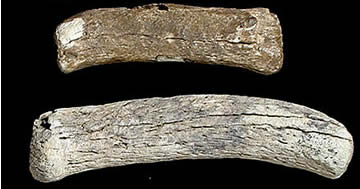
These flintknapping tools made of antler
and bone were used to make stone tools. The larger specimens
likely served as "billets" or soft hammers for striking
flakes off pieces of stone, such as flint or chert, whereas
the three pointed antler tools on right are flaking tools
used to remove small flakes from nearly completed chipped
stone tools.
Food Processing, Cooking, and Storage
Amid the quantities of burned rock and other
hearth debris were quantities of grinding stone fragments
and pottery sherds—all that remained of the food processors,
cooking pots, and "Tupperware" of prehistoric times.
Milling and grinding implements, such as manos and metates,
were important processing tools for farming peoples who grew
corn. It is likely that—along with corn kernels—grass
seeds, mesquite beans, and nuts also were ground into flour
for making bread.
Of the handheld manos, some were made of hard
sandstone, others of quartzite or a hard, sandy limestone.
Most of the nearly 160 manos had been pecked or worked into
an oval shape, and showed signs of heavy wear. Two manos with
traces of red pigment may have been used for grinding hematite
or ocher for paint. The grinding slabs, often known as metates,
chiefly were made of hard sandstone; only 10 whole ones were
found among the 81 metate specimens. Grinding slab fragments
were often reused as cooking stones, or griddles; many of
these were found among the hearth stones.
Although a great deal of cooking involved use
of small hearths, ovens, and flat stone griddles, simple clay
pots were used for cooking stew-like meals and also for hauling
and storing water. To make the vessels, potters used crushed
mussel shell as a tempering agent and formed long coils of
clay into globular jars and deep bowls. The globular jars,
which had rounded bases, likely were cooking vessels.
Among the roughly 600 potsherds recovered at
the site, none could be refitted into whole vessels. Based
on similarities and differences, at least 25-30 separate vessels
are represented, according to a recent reexamination of the
collection by archeologist Michael Brack. Judging from the
sherds, most of the vessels were round-bottomed jars with
restricted necks, many of which flared out at the rims. The
openings of these jars were small—averaging 6 inches
(15 cm). A few bowls (at least 4) are also in the collection.
The vast majority of the site's potsherds (98%) are shell-tempered
plainwares, a few with simple decorations. Among the decorated
pieces, most had rows of appliquéd nodes; others had
vertical fingernail marks, incised diagonal lines, and stamped
impressions on the vessel body.
Krieger defined this type of pottery—shell-tempered,
coiled, globular-shaped, plain to only minimally decorated—from
the north central Texas area as Nocona Plain on the basis
of the Harrell site collection. The pottery was one of the
main "traits" or characteristics of the Henrietta
focus. Freshly crushed mussel shell was added as temper in
almost all the pottery from the site. Brack's study of shell-tempered
pottery from north Texas and Oklahoma found that the Harrell
site's pottery is the most technologically varied of any assemblage,
but closely resembles pottery found at sites along the Red
River and the Washita and Canadian River drainages in southern
and western Oklahoma. The variety of pottery and relatively
large number of vessels suggests that much of the pottery
found at Harrell was locally made.
A handful of very interesting and peculiar thick
pottery sherds up to an inch thick were unlike the other shell-tempered
pieces at the site. These appear to be fragments of small
"paint pots"-tall, narrow cylinders with 2-to 3-inch
(5-7 cm) openings. Two sherds have textured or roughened exteriors;
one with diagonal lines and the other with irregular but closely
spaced fingernail punctures or textile impressions, perhaps
to provide a better hand hold on the vessels. Interiors are
bright red, possibly from holding paint made of ochre. Similar
pottery has been found at other post A.D. 1200 sites in upper
Brazos and Red River locations as well as southern Oklahoma.
Food Remains
Based on charred and fragmentary remains left
behind in the cooking pits and midden rubble, the people of
the north-central Brazos ate a varied diet including buffalo,
deer, birds (turkey and small birds), turtle, freshwater drum
and other fish, and a quantity of freshwater mussels. Meat
would have been dried for use as jerky or pemmican, and bones
boiled or "greased," to extract fat. The later dwellers
also grew corn, as attested to by the fragments of charred
corn cobs preserved at the site, and collected pecans and
wild plums. Although few other food remains were recovered,
this is mainly because the archeologists did not realize the
importance of collecting charcoal and soil samples from hearths
and of using fine screening techniques to recover the bones
of small creatures. Based on what is known from other sites
in the region, we can guess that they also hunted a variety
of small mammals, collected the beans and acorns of the abundant
mesquite and oak trees in the area, and gathered a variety
of other plants, grasses, and seeds. Cactus, abundant today
in the area, may have been exploited for a variety of uses
as well.
In addition to the "tropical" domesticates"
such as corn, they probably raised other crops such as beans
and squash. Drass's study of earlier Washita River sites suggests
that domestication of plants on the southern Plains may have
started much earlier, with eastern Woodland domesticates such
as sun flower, marsh elder, and chenopodium.
Art, Ceremony, and Trade
An intricately incised bird bone with cross
hatched designs may have been used as an ornament or in a
special ritual.
Among the quantities of tools, debris, and more
mundane objects of daily life were a small number of items
bespeaking a desire to bring beauty and ceremony into the
lives of the people living along the Brazos. There were also
objects that indicated contact with groups in regions far
afield. Based on the array of "jewelry" found at
the site, at least some members of the group wore body ornaments,
including beads made of bone, fossil crinoids, and Olivella
shell, the latter from the Gulf of California over 700 miles
to the southwest. Cut and perforated mussel shells were probably
worn as pendants. Certain other mussel shell sections appeared
to be pendants or tools in the making—unfinished "blanks"
or oval discs cut from flat sections of larger shells.
Certain items may have been used in ceremonies
including elbow pipes for smoking native tobacco, tubes or
beads of bird bone, and rasps. The smoking pipes were made
of hard, fine-grained sandstone, and several were decorated
with lines incised around the pipe bowl rim, or with nicks
cut at intervals around the rim. This latter specimen also
has a hole drilled from the outside near the junction of stem
and bowl; archeologist Jack Hughes likened this specimen to
modern "carburetor" pipes. One interesting specimen
clearly saw much use, as indicated by a highly blackened bowl
interior.
Several distinctive sherds of pottery found
at the site were almost certainly brought or traded in from
other areas: one of southeastern New Mexico Brownware, and
one engraved sherd from the East Texas Caddo area.
That there was interaction or trade with people
from areas far afield is suggested in several items left at
the site including tools made from Alibates flint from the
Texas Panhandle, a biface made of black obsidian from the
Rocky Mountains to the west or northwest, Olivella shell from
the Gulf of California, and sherds of pottery unlike that
made at the site. One orange-colored polished sherd with an
incised design appears to be Poynor Engraved, a pottery type
made by Late Prehistoric groups along the upper Neches in
the East Texas Caddo area. Another is a Brownware sherd from
southeastern New Mexico. These probably represent trade wares
and suggest that the Harrell site was part of a larger trade
network. Both Southwestern and Caddo peoples were known to
be prodigious traders at various times in their history.
|
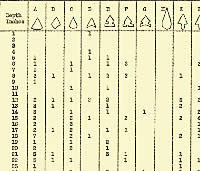
An initial attempt at analyzing artifact
distribution, George Fox's inventory of what he called "microliths," or small chipped stone tools
such as arrow points, was based on the depth at which
they were uncovered. Document from TARL Archives.
Click images to enlarge
|
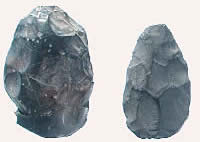
Shaped hematite tools such as these
may once have been hafted on a wooden handle or used
as fist axes. The edges of these specimens have been
polished through use.
|
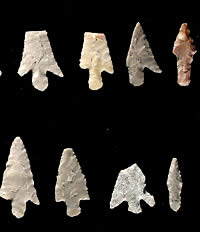
Tiny arrow points, known to collectors
as "bird points" for their small size, were
capable of felling large animals such as bison as well
as much smaller prey.
|
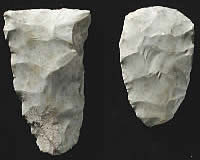
Chipped stone gouges or end scrapers with beveled
bit ends would have been effective tools for woodworking
or hide scraping.
|
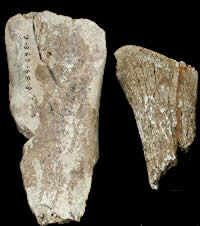
Hoes made of bone. Prehistoric Plains
farmers used bone-tipped hoes and other simple digging
tools to cultivate corn and probably other crops as
well.
|
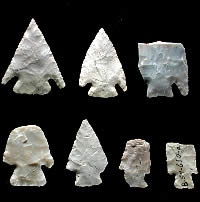
Dart points from earlier times at
the campsite: corner notched, wide-bladed Castroville,
Marcos and Marshall types dating to the Late Archaic
period roughly 2000-2500 years ago.
|
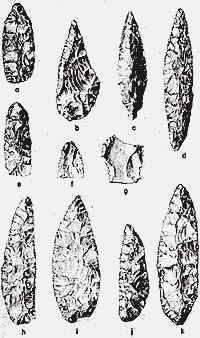
Edge beveling of bifacial knives
is well illustrated in this drawing. Specimen b is a
"two-bevel form" and c-d are "four-bevel
forms." Item i is a biface in an early stage of
use, suggesting what the original size and shape might
have been before successive edge use-wear and resharpening
processes. While beveling reduces the width and causes
edges to become increasingly beveled or angled, the
tool's thickness is maintained and durability enhanced.
Item g is a simple cutting tool made on a flake. (Size
½; drawing from Krieger 1946, Figure 7.)
|
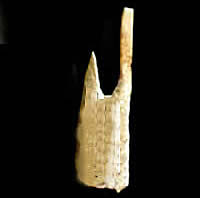
Prehistoric fishermen might have
tied thin sinew or plant fibers to bone fishhooks, such
as this unfinished specimen from the Harrell site, for
fishing in the nearby Clear Fork River.
|
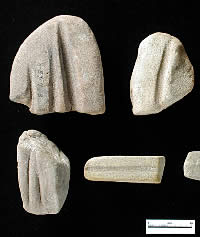
Grooved sandstones such as these
may have served as abraders, or whetstones, to variously
sharpen, dull, or smooth the edges of stone tools, or
for straightening or polishing wooden arrow shafts or
bone tools during manufacturing.
|
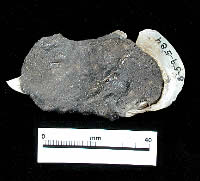
Filled with pitch or asphaltum, early
forms of glue, this mussel shell made a handy container.
The pitch may have been used to secure chipped stone
tools and points into the hafts of handles and shafts.
|
| |
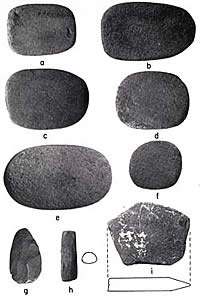
Manos and other stone implements
used for food processing at the Harrell site. Pecked,
or shaped, grinding tools such as manos ( a-e) were
handheld and likely moved in a back and forth motion
on a metate or coarse grinding slab. The small, unshaped
sandstone mano (f) was used in a rotary motion. Item
g is a chipped hematite blade, h, a polished sandstone
cylinder-shaped object, and i, a fragment of a beveled-edge
sandstone tablet. (Krieger 1947, Figure 12).
|
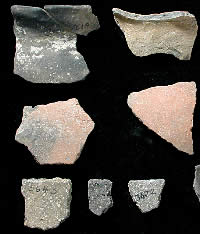
Crushed shell temper shows up as
white flecks within pottery sherds of Nocona Plain.
The variation in color is due largely to differences
in firing this simple pottery.
|
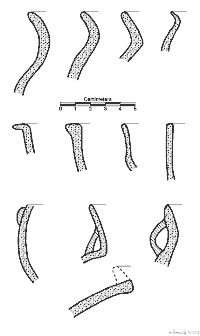
Rim profiles of shell-tempered Nocona
Plain pottery vessels from the Harrell site. Jars and
bowls with globular bodies and rounded bases were the
primary vessel shapes. Drawing from Michael Brack, 1999.
|
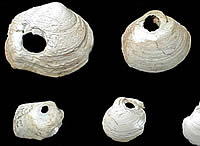
Mussel shells with mysterious holes.
Mussels gathered from nearby rivers were a useful resource
for the peoples of the area, as evidenced by the tens
of thousands of shells recovered at the site. In addition
to eating the fleshy mollusks, the Harrell site people
also used the shells as tools and containers, cut them
into beads and pendants, and crushed them for temper
in making pottery. The purpose of the holes, found on
many of shells, is unknown.
|
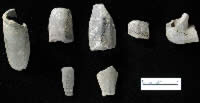
Now in fragments, these sandstone
pipes may have been smoked in special ceremonies. The
specimen on left has been decorated with incised lines
and small nicks around the rim; the elbow pipe on far
right shows the right angle juncture for which it is
named.
|
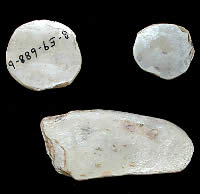
To make disc beads and pendants from
mussel shell, workers would cut sections of the shells
near the hinge, shape them into circular discs or other
forms, and perforate them to be strung on a cord.
|
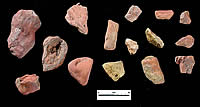
Brightly colored hematite stones,
or ocher, may have been ground for pigment used for
body paint. Several manos, or grinding stones, from
the site bore traces of red pigment as did fragments
of pottery cups.
|
|
